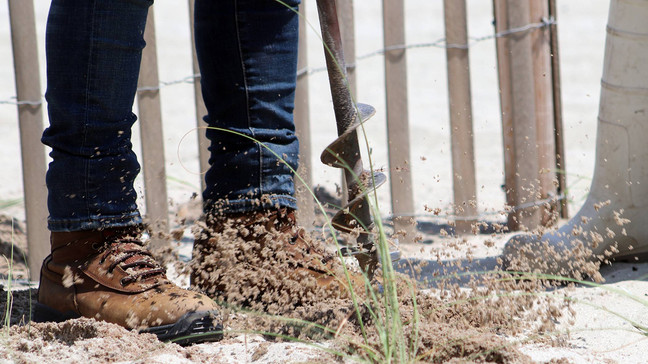Boosting Scotland's Coastline: The Importance Of Seagrass Planting

Table of Contents
The Ecological Benefits of Seagrass Meadows
Seagrass meadows are often called the "lungs of the sea" for their remarkable ability to sequester carbon dioxide, contributing significantly to carbon sequestration in Scotland. These underwater ecosystems provide a multitude of ecological services, supporting a rich tapestry of marine biodiversity. Their ecological importance is undeniable:
-
Nursery Grounds and Habitat: Seagrass provides crucial habitat and nursery grounds for countless fish and invertebrate species, including commercially important fish like cod and plaice. Many species rely on seagrass for shelter, food, and breeding. The intricate structure of the seagrass beds provides refuge from predators, allowing juvenile fish and invertebrates to thrive.
-
Carbon Sequestration Powerhouse: Seagrass meadows are incredibly efficient carbon sinks, absorbing and storing significant amounts of atmospheric CO2. This "blue carbon" plays a crucial role in mitigating climate change, making seagrass restoration a powerful climate action strategy for Scotland.
-
Water Quality Improvement: Seagrass acts as a natural filter, trapping sediments and pollutants, thereby improving water clarity and quality. This benefits not only marine life but also contributes to healthier coastal waters for recreational use.
-
Coastal Protection: The dense root systems of seagrass stabilize sediments, reducing coastal erosion and protecting shorelines from the impacts of storms and rising sea levels. This natural coastal protection is increasingly vital in the face of climate change.
-
Complex Food Web Support: Seagrass supports a complex food web, providing sustenance for a wide array of species, from small crustaceans to larger fish and marine mammals. A healthy seagrass ecosystem underpins the overall health and resilience of the marine environment.
Seagrass Planting Initiatives in Scotland
Recognizing the importance of seagrass restoration, several initiatives are underway in Scotland. Government agencies, NGOs, and community groups are actively involved in various seagrass planting projects, employing different methods to restore these vital ecosystems.
-
Leading Organizations: Organizations such as Marine Scotland, the Scottish Wildlife Trust, and various local community groups are at the forefront of seagrass restoration efforts. They work collaboratively to identify suitable sites, plan planting operations, and monitor the success of restoration projects.
-
Planting Methods: Seagrass restoration employs various techniques, including seed dispersal (using naturally collected or cultivated seeds) and transplanting (carefully relocating seagrass shoots from healthy areas to degraded sites). The choice of method depends on factors such as site conditions and available resources.
-
Successful Case Studies: While still relatively nascent, several seagrass restoration projects in Scotland have already shown promising results, demonstrating the feasibility and effectiveness of these initiatives. These successes offer valuable lessons for future projects and inspire continued effort.
-
Funding and Government Support: Increasingly, seagrass restoration is receiving greater funding and government support, recognizing its significant ecological and economic value. This funding enables larger-scale projects and long-term monitoring efforts.
The Economic and Social Benefits of Coastal Restoration
The restoration of seagrass meadows in Scotland brings not only ecological benefits but also significant economic and social advantages. A healthy coastline, supported by thriving seagrass, enhances the quality of life for coastal communities and boosts the local economy.
-
Sustainable Tourism: Vibrant seagrass meadows attract tourists, supporting local businesses and creating opportunities in sustainable tourism. Healthy coastal ecosystems are a major draw for ecotourism and recreational activities.
-
Fishing Community Support: Improved water quality and increased fish stocks, thanks to restored seagrass habitats, directly benefit local fishing communities, contributing to their livelihoods and economic stability.
-
Green Job Creation: Seagrass restoration creates green jobs in areas such as planting, monitoring, and research, providing employment opportunities in coastal communities.
-
Coastal Resilience: Seagrass meadows enhance coastal resilience to climate change impacts, reducing the costs associated with erosion and storm damage, benefiting both the environment and the economy.
Engaging Communities in Seagrass Conservation
Community engagement is crucial for the long-term success of seagrass restoration projects. Citizen science initiatives and volunteer opportunities provide valuable support and foster a sense of ownership and stewardship within local communities.
-
Citizen Science: Community involvement in seagrass monitoring provides valuable data for researchers, enhancing the effectiveness of restoration efforts. Citizens can participate in surveys, data collection, and other monitoring activities.
-
Volunteer Opportunities: Hands-on involvement in seagrass planting and habitat restoration activities fosters a deeper connection with the marine environment and creates a sense of shared responsibility for its protection.
-
Environmental Education: Educating the public about the importance of seagrass ecosystems raises awareness and encourages support for conservation efforts. This increased understanding fosters a greater commitment to protecting this vital resource.
Conclusion
Seagrass planting in Scotland is not merely an environmental initiative; it’s a multifaceted strategy with significant ecological, economic, and social benefits. The restoration of these vital underwater meadows contributes to carbon sequestration, enhanced biodiversity, improved water quality, and coastal protection. Furthermore, it supports sustainable tourism, strengthens local economies, and fosters a sense of community stewardship. The urgency of these initiatives cannot be overstated in the face of climate change and habitat degradation.
Join the movement to boost Scotland's coastline! Learn more about seagrass planting and how you can contribute to this vital conservation effort. Find opportunities to get involved in seagrass restoration projects near you and help protect Scotland's precious marine environment. Support organizations working to restore Scotland's seagrass meadows and be a part of a healthier, more resilient future for Scotland's coast.

Featured Posts
-
 Indy Cars 2024 Season A Look At Foxs Broadcast Plans
May 04, 2025
Indy Cars 2024 Season A Look At Foxs Broadcast Plans
May 04, 2025 -
 The Count Of Monte Cristo Review A Timeless Classic
May 04, 2025
The Count Of Monte Cristo Review A Timeless Classic
May 04, 2025 -
 Nhl Playoffs Analyzing The Tight Western Conference Wild Card Race
May 04, 2025
Nhl Playoffs Analyzing The Tight Western Conference Wild Card Race
May 04, 2025 -
 Political Responsibility In New Caledonia Valls Third Trip
May 04, 2025
Political Responsibility In New Caledonia Valls Third Trip
May 04, 2025 -
 Ufc London Kevin Hollands Fight For Relevance
May 04, 2025
Ufc London Kevin Hollands Fight For Relevance
May 04, 2025
